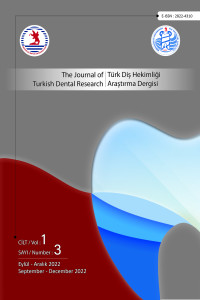Öz
Aim: The aim of this in vitro study was to evaluate the effect of mouthrinses and thermocycling on the color stability of all-ceramic materials.
Materials and methods: A total of 100 all-ceramic samples with a thickness of 1.5 mm were prepared by applying dentin porcelain to the substructures within 0.5x10x10 mm dimensions. Color data were recorded with a spectrophotometer and color differences were calculated with CIEDE2000 formula. After baseline measurements (T0), the samples were equally divided into 2 groups (Group A and Group B). Samples in group A exposed to aging in a thermocycling device and color changes were recorded (T1). Groups were then divided into 5 subgroups (n:10) and the samples were immersed in Klorhex®, Listerine Total Care®, Tantum Verde®, Meridol® and distilled water for 12 hours. The last color changes were recorded (T2) and the color difference values (ΔE00) were statistically compared with the Kruskal-Wallis and Mann-Whitney U tests.
Results: Meridol® was statistically different from other mouthrinses except for Listerine Total Care® (p<0.001). Listerine Total Care® was statistically different from distilled water in both groups (p<0.05). In group A, the mean values in Meridol® were within the perceptible limits and Listerine Total Care® were within the acceptable limits (T0-T2). The mean values of mouthrinses in group B were below the perceptible limits (T0-T2). Thermocycling did not cause a statistically significant color difference (T0-T1).
Conclusion: Prolonged use of mouthrinses may cause color change in all-ceramic materials. Mouthrinses containing amine/stannous fluoride (Meridol®) should be recommended with caution for daily use.
Anahtar Kelimeler
Kaynakça
- 1. Daou EE. The zirconia ceramic: strengths and weaknesses. Open Dent J. 2014;8:33.
- 2. Alfawaz Y. Zirconia crown as single unit tooth restoration: a literature review. J Contemp Dent Pract. 2016;17(5):418-22.
- 3. Blatz MB. Long-term clinical success of all-ceramic posterior restorations. Quintessence Int. 2002;33(6): 415-36.
- 4. Piconi C, Maccauro G. Zirconia as a ceramic biomaterial. Biomaterials. 1999;20(1):1-25.
- 5. Anusavice K. Phillips’ science of dental materials, ed 11, St Louis, 2003. Elsevier Science. Smith DC. A new dental cement. Br Dent J. 1968;124(9):381-84.
- 6. Kelly JR, Denry I. Stabilized zirconia as a structural ceramic: an overview. Dent Mat. 2008;24(3):289-98.
- 7. Rekow E, Silva N, Coelho P, et al. Performance of dental ceramics: challenges for improvements. J Dent Res. 2011;90(8):937-52.
- 8. Artopoulou II, Powers JM, Chambers MS. In vitro staining effects of stannous fluoride and sodium fluoride on ceramic material. J Prosthet Dent. 2010;103(3):163-69.
- 9. Guignone BC, Silva LK, Soares RV, et al. Color stability of ceramic brackets immersed in potentially staining solutions. Dental Press J Orthod. 2015;20:32-38.
- 10. Gaintantzopoulou M, Kakaboura A, Vougiouklakis G. Colour stability of tooth-coloured restorative materials. Europ J Prosthos Rest Dent. 2005;13(2):51-56.
- 11. Powers JM, Dennison JB, Lepeak PJ. Parameters that affect the color of direct restorative resins. J Dent Res. 1978;57(9-10):876-80.
Öz
Amaç: Mevcut in vitro çalışmanın amacı, tam seramik malzemelerin renk stabilitesi üzerinde ağız gargaraları vetermal döngünün etkisini değerlendirmektir. Bulgular: MER’in renk farklılıkları, LIS dışında grup A ve grup B’deki diğer gargaralardan istatistiksel olarak farklı bulundu (p<0,001). LIS her iki grupta da DIS’den istatistiksel olarak anlamlı farklılık gösterdi (p<0.05). Grup A’da MER’deki ortalama değerler algılanabilir sınırlar içinde olup, LIS’deki ortalama değerler kabul edilebilir sınırlar içinde belirlendi (T0-T2). Grup B’de gargaraların ortalama değerleri algılanabilir sınırların (T0-T2) altında hesaplandı. Termal döngü ile yaşlandırma istatistiksel olarak anlamlı bir renk farklılığına (T0-T1) neden olmadı. Sonuç: Ağız gargaralarının uzun süreli kullanımı tam seramik malzemelerde renk değişikliğine neden olabilir. Amin/kalay florür içeren ağız garagaraları (MER) günlük kullanım için dikkatle önerilmelidir.
Anahtar Kelimeler
Seramik Renk Stabilitesi Ağız Gargarası Termosiklus Yaşlanma
Kaynakça
- 1. Daou EE. The zirconia ceramic: strengths and weaknesses. Open Dent J. 2014;8:33.
- 2. Alfawaz Y. Zirconia crown as single unit tooth restoration: a literature review. J Contemp Dent Pract. 2016;17(5):418-22.
- 3. Blatz MB. Long-term clinical success of all-ceramic posterior restorations. Quintessence Int. 2002;33(6): 415-36.
- 4. Piconi C, Maccauro G. Zirconia as a ceramic biomaterial. Biomaterials. 1999;20(1):1-25.
- 5. Anusavice K. Phillips’ science of dental materials, ed 11, St Louis, 2003. Elsevier Science. Smith DC. A new dental cement. Br Dent J. 1968;124(9):381-84.
- 6. Kelly JR, Denry I. Stabilized zirconia as a structural ceramic: an overview. Dent Mat. 2008;24(3):289-98.
- 7. Rekow E, Silva N, Coelho P, et al. Performance of dental ceramics: challenges for improvements. J Dent Res. 2011;90(8):937-52.
- 8. Artopoulou II, Powers JM, Chambers MS. In vitro staining effects of stannous fluoride and sodium fluoride on ceramic material. J Prosthet Dent. 2010;103(3):163-69.
- 9. Guignone BC, Silva LK, Soares RV, et al. Color stability of ceramic brackets immersed in potentially staining solutions. Dental Press J Orthod. 2015;20:32-38.
- 10. Gaintantzopoulou M, Kakaboura A, Vougiouklakis G. Colour stability of tooth-coloured restorative materials. Europ J Prosthos Rest Dent. 2005;13(2):51-56.
- 11. Powers JM, Dennison JB, Lepeak PJ. Parameters that affect the color of direct restorative resins. J Dent Res. 1978;57(9-10):876-80.
Ayrıntılar
| Birincil Dil | İngilizce |
|---|---|
| Konular | Diş Hekimliği |
| Bölüm | Araştırma Makaleleri |
| Yazarlar | |
| Yayımlanma Tarihi | 15 Aralık 2022 |
| Yayımlandığı Sayı | Yıl 2022 Cilt: 1 Sayı: 3 |

